“Bewitching family, which has wonderfully used the possibilities given by evolution, to develop a complex but fascinating flower pattern“, so says the botanist of this family in which you know well dok hak, “love flower”, Calotropis with amazing waxy flowers. Today we will talk about Asclepias curassavica, whose learned name is already quite a program. Linnaeus named this genus after the Greek god of medicine, Asclepius, because most of these plants are very famous in traditional medicine. He added curassavica for the species we are interested in because it comes from South America and therefore also from Curaçao, a small island in the North East of this continent.
It was introduced in Europe in the XVIIth century, because considered at first as the Ipecac, major medicinal plant of the New World with the Quinquina. However, it was only a false ipecac or bastard ipecac, name which remained to him in the European languages. In New Caledonia, the plant would have been introduced towards 1860 by a gendarme come from Martinique which would have stuffed cushions of its silky seeds thus dispersing the plant in the area where it became invasive under the name of grass to the gendarme. In India, it has long been an important medicinal plant and is also found throughout the Indochina peninsula. The Lao call it kha kay, “chicken feet” and the Thai fay deuan ha, “fifth month cotton”. This means that this American plant has become naturalized in most tropical and subtropical regions where it thrives in grasslands, gullies, open forests, sandy soils, and areas with disturbed vegetation.
Ipecac is a shrub with alternate, evergreen, bluish-green leaves; they are narrow and long with a pointed apex. The flowers are grouped in umbels of 6 to 8 units at the end of branch; each one is composed of a calyx with 5 green sepals, a corolla with 5 red-orange petals, and 5 stamens welded fleshy, forming a yellow to yellow-orange crown in the center. The fruit is a dehiscent follicle which, with maturity, releases seeds provided with silks which fly away with the liking of the winds, thus supporting the dispersion of the plant. Let us add that all the parts of the plant contain a white latex which can cause skin irritations.
In Laos, kha kay is found in some gardens because its brightly colored flowers are very decorative and attract butterflies, bees and birds. Although there are no traditional medical uses here, more modern herbalists offer preparations containing kha kay as a heart tonic, antiseptic after childbirth, and treatment of high fevers. Traditionally in America, Ipecac is essentially a plant that makes you spit and vomit and is strongly purgative; it was among other things very much used in case of poisoning, which is why it is called in the West Indies zèb man bwaven, “Madame Boivin’s herb”, after a famous poisoner. The pharmaceutical industry is of course interested in this plant which contains many active ingredients that can also be toxic. It is therefore prudent not to use kha kay in domestic medicine but to leave its use to specialists.
« Envoûtante famille, qui a merveilleusement usé des possibilités données par l’évolution, pour élaborer un schéma de fleur complexe mais fascinant », ainsi parle le botaniste de cette famille dans laquelle vous connaissez bien dok hak, « fleur-amour », Calotropis aux étonnantes fleurs cireuses. Nous parlerons aujourd’hui d’Asclepias curassavica dont le nom savant est déjà tout un programme. Linné a nommé ce genre d’après le dieu de la médecine en Grèce, Asclépios, car la plupart de ces plantes sont très réputées en médecine traditionnelle. Il a ajouté curassavica pour l’espèce qui nous intéresse car elle vient d’Amérique du Sud et donc aussi de Curaçao, petite île au Nord Est de ce continent.
Elle fut introduite en Europe au XVIIe siècle, car considérée d’abord comme l’Ipéca, plante médicinale majeure du Nouveau Monde avec le Quinquina. Mais elle n’était qu’un faux ipéca ou Ipéca bâtard, nom qui lui est resté dans les langues européennes. En Nouvelle Calédonie la plante aurait été introduite vers 1860 par un gendarme venu de Martinique qui aurait bourré des coussins de ses graines soyeuses dispersant ainsi la plante dans la région où elle est devenue envahissante sous le nom d’herbe au gendarme. En Inde elle est depuis longtemps une plante médicinale importante et on la trouve également dans toute la péninsule indochinoise. Les Lao la nomme kha kay, « pattes de poulet » et les Thaï fay deuan ha, « coton du cinquième mois ». C’est dire que cette plante américaine s’est naturalisée dans la plupart des régions tropicales et subtropicales où elle affectionne les prairies, les ravines, les forêts ouvertes, les sols sablonneux, et les zones à végétation perturbée.
L’Ipéca bâtard est un arbuste aux feuilles alternes, persistantes, d’un vert bleuté; elles sont étroites et longues avec un apex pointu. Les fleurs sont groupées en ombelles de 6 à 8 unités en bout de branche; chacune d’elle est composée d’un calice à 5 sépales verts, d’une corolle à 5 pétales rouge orange, et de 5 étamines soudées charnues, formant une couronne jaune à jaune orangée au centre. Le fruit est un follicule déhiscent qui, à maturité, libère des graines munies de soies qui s’envolent au gré des vents, favorisant ainsi la dispersion de la plante. Ajoutons que toutes les parties de la plante contiennent un latex blanc pouvant provoquer des irritations cutanées.
Au Laos on rencontre kha kay dans certains jardins car ses fleurs aux brillantes couleurs sont très décoratives et attirent d’ailleurs les papillons, les abeilles et les oiseaux. S’il n’y a pas ici d’usages médicaux traditionnels, les herboristeries plus modernes proposent des préparations contenant kha kay comme tonique cardiaque, antiseptique après un accouchement, traitement des fortes fièvres. Traditionnellement en Amérique l’Ipéca bâtard est essentiellement une plante qui fait cracher et vomir et qui est fortement purgative; elle était entre autres très utilisée en cas d’empoisonnement, c’est pour quoi on la nomme aux Antilles zèb man bwaven, « herbe à madame Boivin », du nom d’une célèbre empoisonneuse. L’industrie pharmaceutique s’est bien entendu intéressée à cette plante qui contient de nombreux principes actifs et qui peuvent être aussi toxiques. Il est donc prudent de ne pas utiliser kha kay en médecine domestique mais d’en laisser l’usage aux spécialistes.
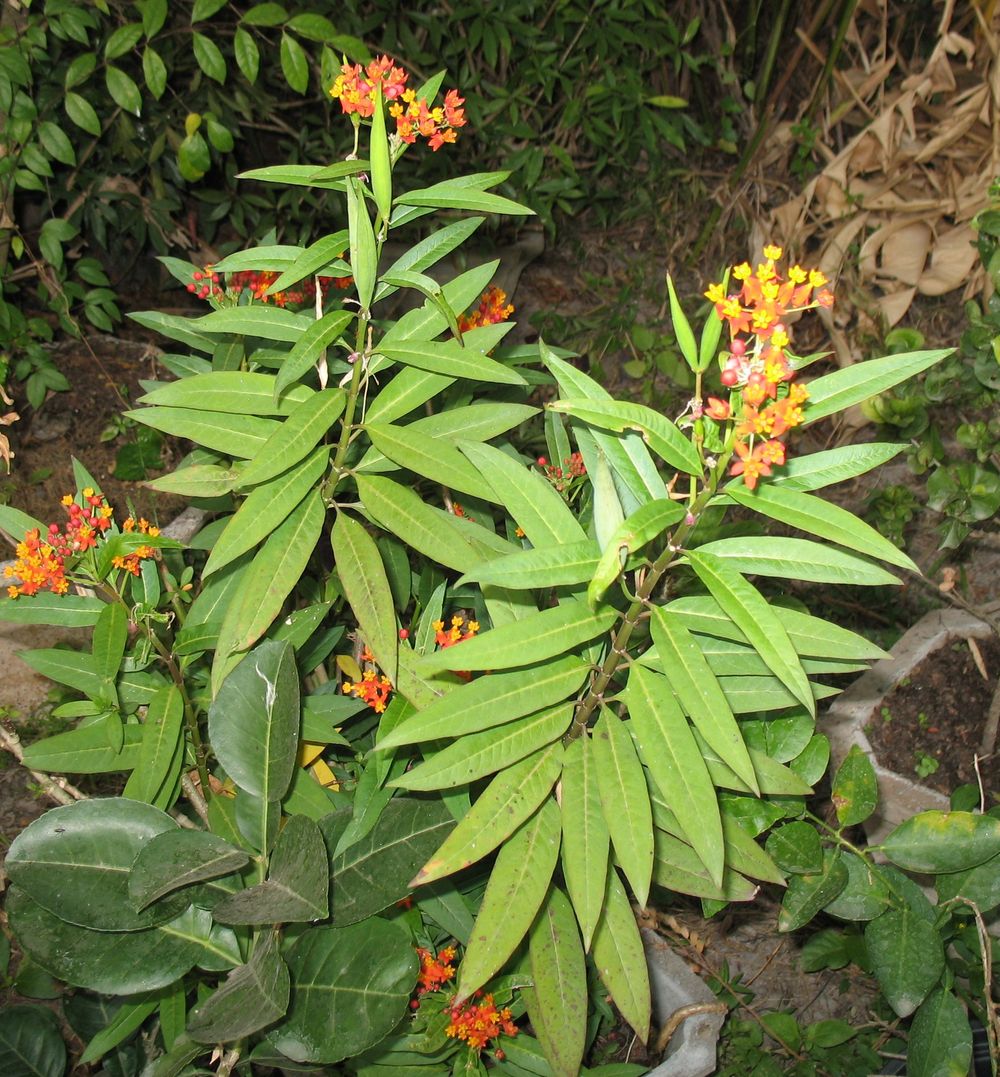
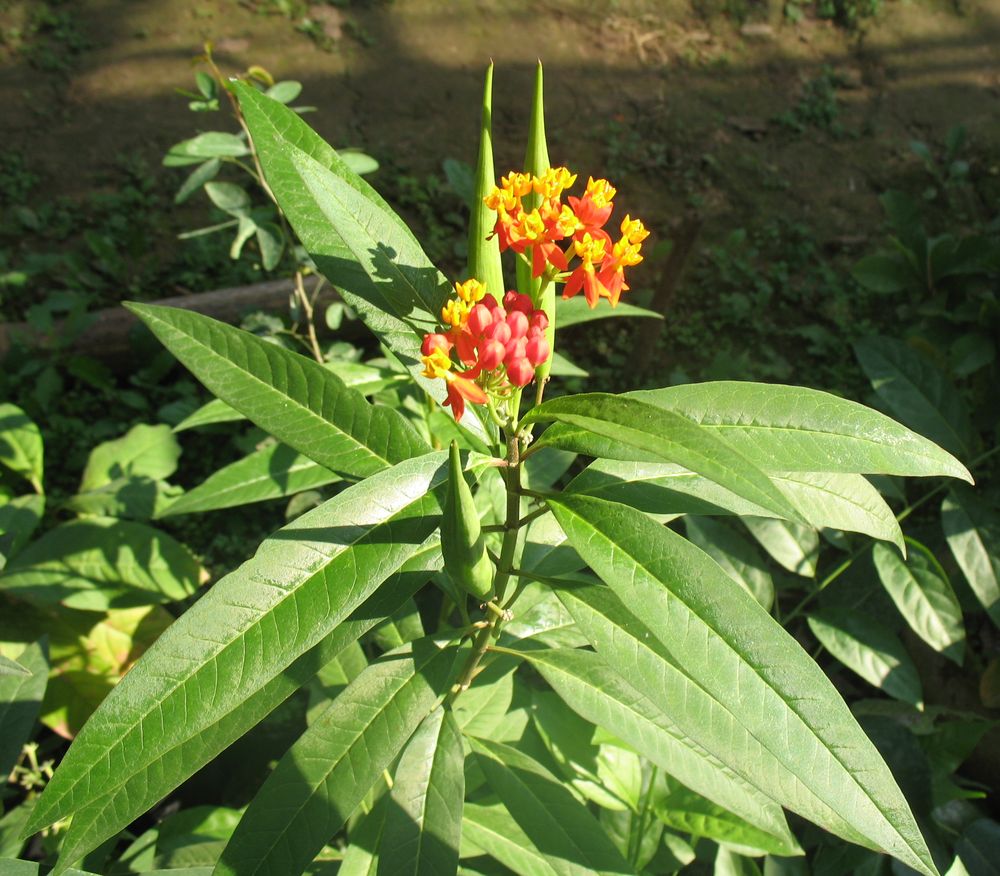
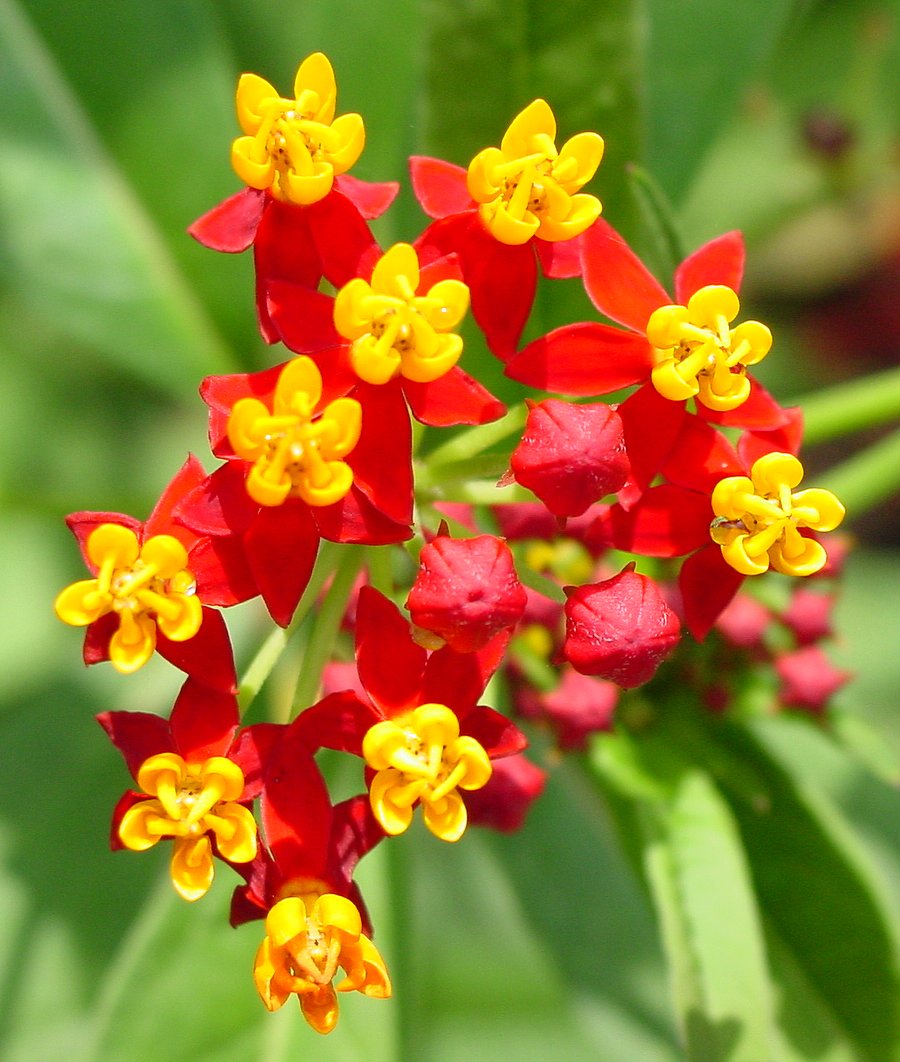
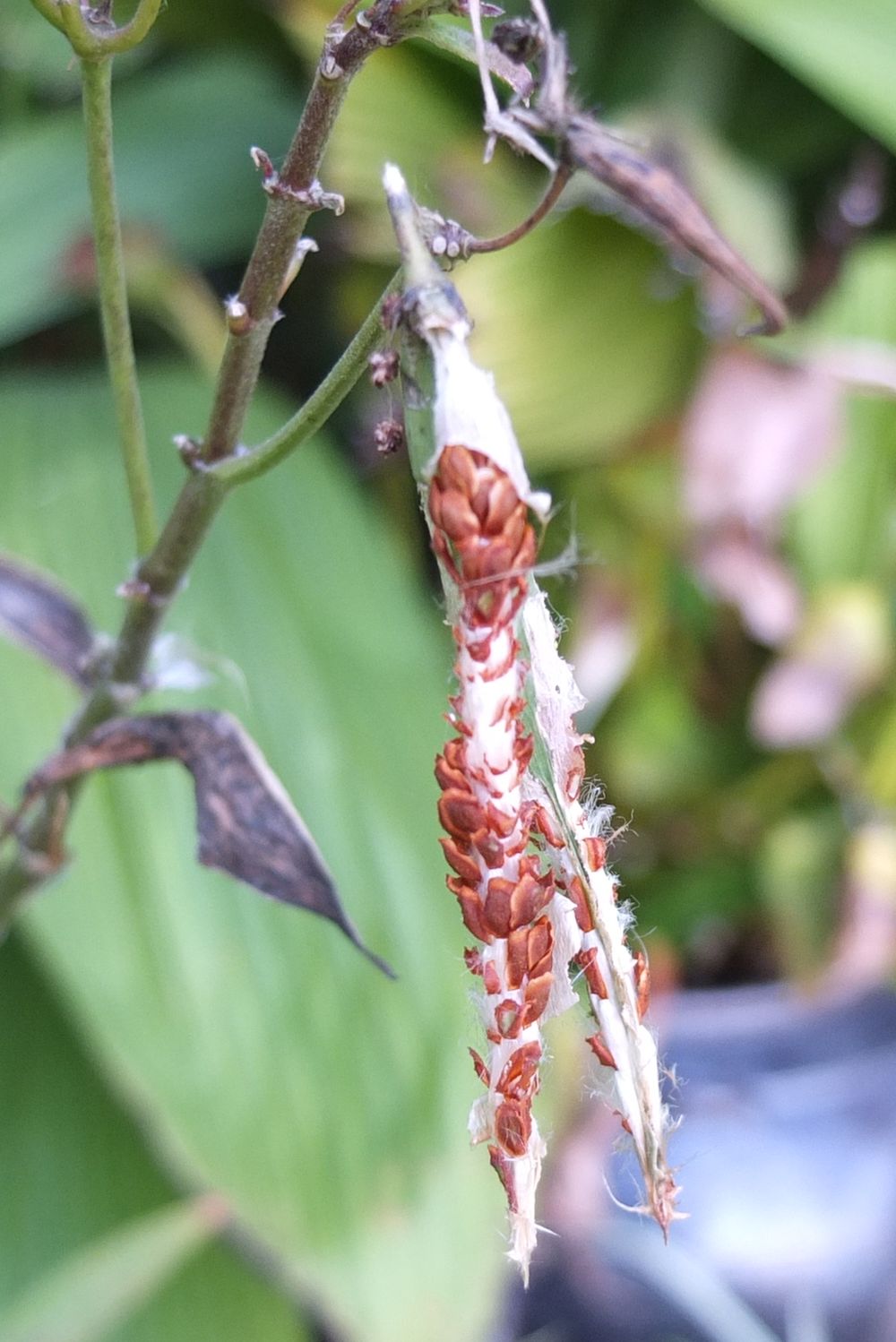
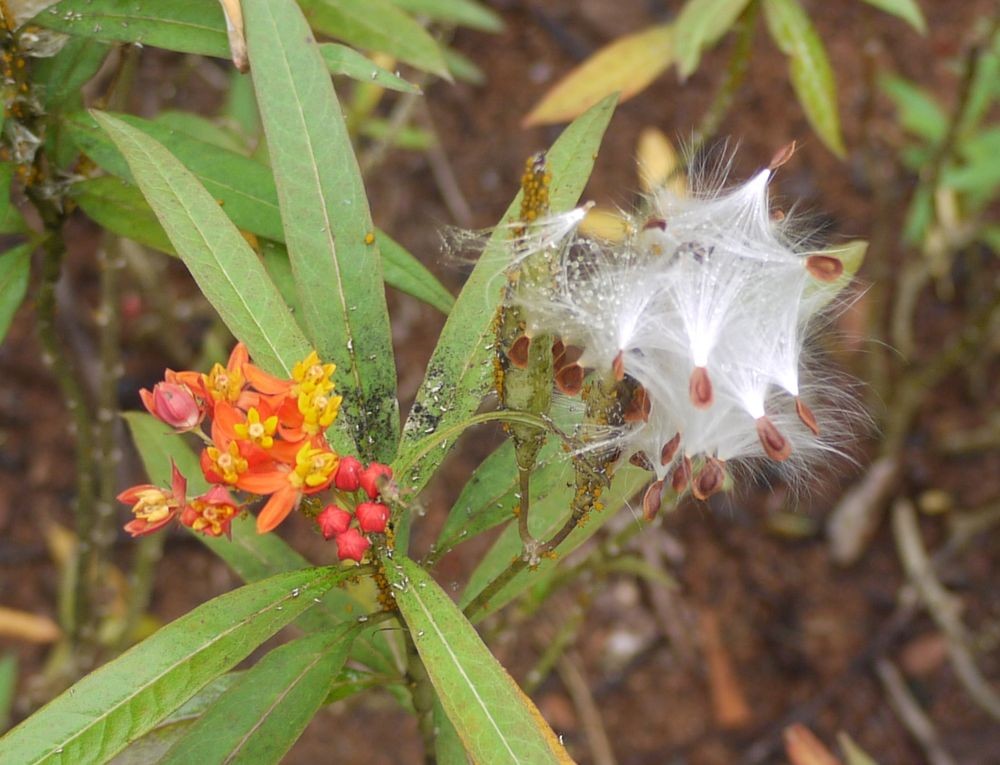
“Bewitching family, which has wonderfully used the possibilities given by evolution, to develop a complex but fascinating flower pattern“, so says the botanist of this family in which you know well dok hak, “love flower”, Calotropis with amazing waxy flowers. Today we will talk about Asclepias curassavica, whose learned name is already quite a program. Linnaeus named this genus after the Greek god of medicine, Asclepius, because most of these plants are very famous in traditional medicine. He added curassavica for the species we are interested in because it comes from South America and therefore also from Curaçao, a small island in the North East of this continent.
It was introduced in Europe in the XVIIth century, because considered at first as the Ipecac, major medicinal plant of the New World with the Quinquina. However, it was only a false ipecac or bastard ipecac, name which remained to him in the European languages. In New Caledonia, the plant would have been introduced towards 1860 by a gendarme come from Martinique which would have stuffed cushions of its silky seeds thus dispersing the plant in the area where it became invasive under the name of grass to the gendarme. In India, it has long been an important medicinal plant and is also found throughout the Indochina peninsula. The Lao call it kha kay, “chicken feet” and the Thai fay deuan ha, “fifth month cotton”. This means that this American plant has become naturalized in most tropical and subtropical regions where it thrives in grasslands, gullies, open forests, sandy soils, and areas with disturbed vegetation.
Ipecac is a shrub with alternate, evergreen, bluish-green leaves; they are narrow and long with a pointed apex. The flowers are grouped in umbels of 6 to 8 units at the end of branch; each one is composed of a calyx with 5 green sepals, a corolla with 5 red-orange petals, and 5 stamens welded fleshy, forming a yellow to yellow-orange crown in the center. The fruit is a dehiscent follicle which, with maturity, releases seeds provided with silks which fly away with the liking of the winds, thus supporting the dispersion of the plant. Let us add that all the parts of the plant contain a white latex which can cause skin irritations.
In Laos, kha kay is found in some gardens because its brightly colored flowers are very decorative and attract butterflies, bees and birds. Although there are no traditional medical uses here, more modern herbalists offer preparations containing kha kay as a heart tonic, antiseptic after childbirth, and treatment of high fevers. Traditionally in America, Ipecac is essentially a plant that makes you spit and vomit and is strongly purgative; it was among other things very much used in case of poisoning, which is why it is called in the West Indies zèb man bwaven, “Madame Boivin’s herb”, after a famous poisoner. The pharmaceutical industry is of course interested in this plant which contains many active ingredients that can also be toxic. It is therefore prudent not to use kha kay in domestic medicine but to leave its use to specialists.
« Envoûtante famille, qui a merveilleusement usé des possibilités données par l’évolution, pour élaborer un schéma de fleur complexe mais fascinant », ainsi parle le botaniste de cette famille dans laquelle vous connaissez bien dok hak, « fleur-amour », Calotropis aux étonnantes fleurs cireuses. Nous parlerons aujourd’hui d’Asclepias curassavica dont le nom savant est déjà tout un programme. Linné a nommé ce genre d’après le dieu de la médecine en Grèce, Asclépios, car la plupart de ces plantes sont très réputées en médecine traditionnelle. Il a ajouté curassavica pour l’espèce qui nous intéresse car elle vient d’Amérique du Sud et donc aussi de Curaçao, petite île au Nord Est de ce continent.
Elle fut introduite en Europe au XVIIe siècle, car considérée d’abord comme l’Ipéca, plante médicinale majeure du Nouveau Monde avec le Quinquina. Mais elle n’était qu’un faux ipéca ou Ipéca bâtard, nom qui lui est resté dans les langues européennes. En Nouvelle Calédonie la plante aurait été introduite vers 1860 par un gendarme venu de Martinique qui aurait bourré des coussins de ses graines soyeuses dispersant ainsi la plante dans la région où elle est devenue envahissante sous le nom d’herbe au gendarme. En Inde elle est depuis longtemps une plante médicinale importante et on la trouve également dans toute la péninsule indochinoise. Les Lao la nomme kha kay, « pattes de poulet » et les Thaï fay deuan ha, « coton du cinquième mois ». C’est dire que cette plante américaine s’est naturalisée dans la plupart des régions tropicales et subtropicales où elle affectionne les prairies, les ravines, les forêts ouvertes, les sols sablonneux, et les zones à végétation perturbée.
L’Ipéca bâtard est un arbuste aux feuilles alternes, persistantes, d’un vert bleuté; elles sont étroites et longues avec un apex pointu. Les fleurs sont groupées en ombelles de 6 à 8 unités en bout de branche; chacune d’elle est composée d’un calice à 5 sépales verts, d’une corolle à 5 pétales rouge orange, et de 5 étamines soudées charnues, formant une couronne jaune à jaune orangée au centre. Le fruit est un follicule déhiscent qui, à maturité, libère des graines munies de soies qui s’envolent au gré des vents, favorisant ainsi la dispersion de la plante. Ajoutons que toutes les parties de la plante contiennent un latex blanc pouvant provoquer des irritations cutanées.
Au Laos on rencontre kha kay dans certains jardins car ses fleurs aux brillantes couleurs sont très décoratives et attirent d’ailleurs les papillons, les abeilles et les oiseaux. S’il n’y a pas ici d’usages médicaux traditionnels, les herboristeries plus modernes proposent des préparations contenant kha kay comme tonique cardiaque, antiseptique après un accouchement, traitement des fortes fièvres. Traditionnellement en Amérique l’Ipéca bâtard est essentiellement une plante qui fait cracher et vomir et qui est fortement purgative; elle était entre autres très utilisée en cas d’empoisonnement, c’est pour quoi on la nomme aux Antilles zèb man bwaven, « herbe à madame Boivin », du nom d’une célèbre empoisonneuse. L’industrie pharmaceutique s’est bien entendu intéressée à cette plante qui contient de nombreux principes actifs et qui peuvent être aussi toxiques. Il est donc prudent de ne pas utiliser kha kay en médecine domestique mais d’en laisser l’usage aux spécialistes.










“Bewitching family, which has wonderfully used the possibilities given by evolution, to develop a complex but fascinating flower pattern“, so says the botanist of this family in which you know well dok hak, “love flower”, Calotropis with amazing waxy flowers. Today we will talk about Asclepias curassavica, whose learned name is already quite a program. Linnaeus named this genus after the Greek god of medicine, Asclepius, because most of these plants are very famous in traditional medicine. He added curassavica for the species we are interested in because it comes from South America and therefore also from Curaçao, a small island in the North East of this continent.
It was introduced in Europe in the XVIIth century, because considered at first as the Ipecac, major medicinal plant of the New World with the Quinquina. However, it was only a false ipecac or bastard ipecac, name which remained to him in the European languages. In New Caledonia, the plant would have been introduced towards 1860 by a gendarme come from Martinique which would have stuffed cushions of its silky seeds thus dispersing the plant in the area where it became invasive under the name of grass to the gendarme. In India, it has long been an important medicinal plant and is also found throughout the Indochina peninsula. The Lao call it kha kay, “chicken feet” and the Thai fay deuan ha, “fifth month cotton”. This means that this American plant has become naturalized in most tropical and subtropical regions where it thrives in grasslands, gullies, open forests, sandy soils, and areas with disturbed vegetation.
Ipecac is a shrub with alternate, evergreen, bluish-green leaves; they are narrow and long with a pointed apex. The flowers are grouped in umbels of 6 to 8 units at the end of branch; each one is composed of a calyx with 5 green sepals, a corolla with 5 red-orange petals, and 5 stamens welded fleshy, forming a yellow to yellow-orange crown in the center. The fruit is a dehiscent follicle which, with maturity, releases seeds provided with silks which fly away with the liking of the winds, thus supporting the dispersion of the plant. Let us add that all the parts of the plant contain a white latex which can cause skin irritations.
In Laos, kha kay is found in some gardens because its brightly colored flowers are very decorative and attract butterflies, bees and birds. Although there are no traditional medical uses here, more modern herbalists offer preparations containing kha kay as a heart tonic, antiseptic after childbirth, and treatment of high fevers. Traditionally in America, Ipecac is essentially a plant that makes you spit and vomit and is strongly purgative; it was among other things very much used in case of poisoning, which is why it is called in the West Indies zèb man bwaven, “Madame Boivin’s herb”, after a famous poisoner. The pharmaceutical industry is of course interested in this plant which contains many active ingredients that can also be toxic. It is therefore prudent not to use kha kay in domestic medicine but to leave its use to specialists.
« Envoûtante famille, qui a merveilleusement usé des possibilités données par l’évolution, pour élaborer un schéma de fleur complexe mais fascinant », ainsi parle le botaniste de cette famille dans laquelle vous connaissez bien dok hak, « fleur-amour », Calotropis aux étonnantes fleurs cireuses. Nous parlerons aujourd’hui d’Asclepias curassavica dont le nom savant est déjà tout un programme. Linné a nommé ce genre d’après le dieu de la médecine en Grèce, Asclépios, car la plupart de ces plantes sont très réputées en médecine traditionnelle. Il a ajouté curassavica pour l’espèce qui nous intéresse car elle vient d’Amérique du Sud et donc aussi de Curaçao, petite île au Nord Est de ce continent.
Elle fut introduite en Europe au XVIIe siècle, car considérée d’abord comme l’Ipéca, plante médicinale majeure du Nouveau Monde avec le Quinquina. Mais elle n’était qu’un faux ipéca ou Ipéca bâtard, nom qui lui est resté dans les langues européennes. En Nouvelle Calédonie la plante aurait été introduite vers 1860 par un gendarme venu de Martinique qui aurait bourré des coussins de ses graines soyeuses dispersant ainsi la plante dans la région où elle est devenue envahissante sous le nom d’herbe au gendarme. En Inde elle est depuis longtemps une plante médicinale importante et on la trouve également dans toute la péninsule indochinoise. Les Lao la nomme kha kay, « pattes de poulet » et les Thaï fay deuan ha, « coton du cinquième mois ». C’est dire que cette plante américaine s’est naturalisée dans la plupart des régions tropicales et subtropicales où elle affectionne les prairies, les ravines, les forêts ouvertes, les sols sablonneux, et les zones à végétation perturbée.
L’Ipéca bâtard est un arbuste aux feuilles alternes, persistantes, d’un vert bleuté; elles sont étroites et longues avec un apex pointu. Les fleurs sont groupées en ombelles de 6 à 8 unités en bout de branche; chacune d’elle est composée d’un calice à 5 sépales verts, d’une corolle à 5 pétales rouge orange, et de 5 étamines soudées charnues, formant une couronne jaune à jaune orangée au centre. Le fruit est un follicule déhiscent qui, à maturité, libère des graines munies de soies qui s’envolent au gré des vents, favorisant ainsi la dispersion de la plante. Ajoutons que toutes les parties de la plante contiennent un latex blanc pouvant provoquer des irritations cutanées.
Au Laos on rencontre kha kay dans certains jardins car ses fleurs aux brillantes couleurs sont très décoratives et attirent d’ailleurs les papillons, les abeilles et les oiseaux. S’il n’y a pas ici d’usages médicaux traditionnels, les herboristeries plus modernes proposent des préparations contenant kha kay comme tonique cardiaque, antiseptique après un accouchement, traitement des fortes fièvres. Traditionnellement en Amérique l’Ipéca bâtard est essentiellement une plante qui fait cracher et vomir et qui est fortement purgative; elle était entre autres très utilisée en cas d’empoisonnement, c’est pour quoi on la nomme aux Antilles zèb man bwaven, « herbe à madame Boivin », du nom d’une célèbre empoisonneuse. L’industrie pharmaceutique s’est bien entendu intéressée à cette plante qui contient de nombreux principes actifs et qui peuvent être aussi toxiques. Il est donc prudent de ne pas utiliser kha kay en médecine domestique mais d’en laisser l’usage aux spécialistes.


